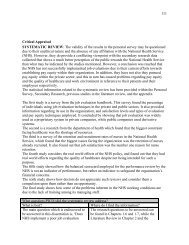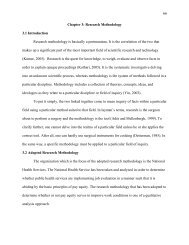13 Chapter 2: Critical Literature Review 2.1 ... - Dissertation
13 Chapter 2: Critical Literature Review 2.1 ... - Dissertation
13 Chapter 2: Critical Literature Review 2.1 ... - Dissertation
You also want an ePaper? Increase the reach of your titles
YUMPU automatically turns print PDFs into web optimized ePapers that Google loves.
34United Kingdom. Any resident who is a member of the National Health Service may receivetreatment in another.The NHS is known to employ more than 1.5 million people in the United Kingdom. 1.3million of these individuals are situated in England. It hires 90,000 hospital doctors, 35,000general practitioners (GPs), 400,000 nurses, and 16,000 ambulance staff who cater to patients inEngland, Scotland, Wales, and Northern Ireland. On a 36-hour average, the system deals with 1million people, with each general practitioner treating 140 patients every week on average. Itspends 60 percent of its budget to pay the staff and 20 percent on drugs, with the rest being usedfor various reasons such as equipment or training (National Health Service, 2009).Currently, there is an allocation of one hundred and £64 billion pounds to the NationalHealth Service between 2009 and 2011, of which £80 billion will be used in 2009-10, and £84billion will be used in 2010-11. It has recently established a new agreement in November 2008with successful negotiation of the new Pharmaceutical Price Regulation Scheme. This schemewill save their companies’ funds to the tune of 350 million pounds a year in 2009-10 and 550million pounds thereafter.Although the National Health Service was originally established as a free universalhealthcare system, it has since been systematically started to become more privatized and hasdismantled various health services. Due to their increased capital spending in the 1970s andincreased financial losses in the ‘90s, the NHS changed their modus operandi and became morebusiness-like. It has consulted its staff and general practitioners to act more like businessmenrather than doctors offering free healthcare. The original concept of service integration and costsharing disappeared and the current organization adopts a more case by case based policy(Pollock, 2004, pp.1-46).





